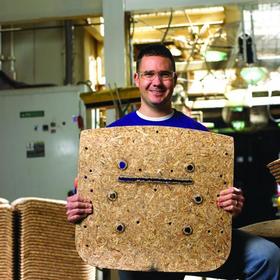Contact Information: CONTACT: Betsy Hoye Advertising & Public Relations Manager 563.272.5690 HoyeB@honcompany.com Jennifer Allanson Robert Falls & Co. Public Relations 216.696.0229 jallanson@robertfalls.com
Green Eggs & Spam: What's New in the Green Office Environment
Instituting Environmental Stewardship in the Workplace Is Easier Than You Think
| Source: The HON Company
MUSCATINE, IA -- (MARKET WIRE) -- April 12, 2007 -- It's time for American offices to go green.
It's not that hard to do. It just takes planning and commitment.
Businesses consume vast amounts of resources. Statistics from the
Worldwatch Institute, an independent environmental research organization,
show that companies in the United States inefficiently use 30 million trees
and 12.5 percent of all domestic electricity annually. Yet most companies
have been slow to incorporate environmental stewardship in goals and
initiatives.
"A variety of new technologies, 'green' products and plenty of benchmarking
studies can easily help shape today's workplace culture into one that
focuses more on environmental stewardship beyond the ubiquitous blue
recycling bin," said Mindy Billingsley, Product Business Manager /
Environmental and Sustainable Initiatives for The HON Company, a leader in
the design and manufacturing of sustainable office furniture. "You want to
recycle, of course, but you also want to reduce waste, conserve energy and
purchase smarter. And to do this, everyone in the company must be on board
and actively participate in the initiative."
Getting Started
Billingsley recommends beginning your commitment to "going green" by
writing an environmental vision statement. "All players from the CEO to
part-time employees need to understand, and buy into, the company's
environmental mission and goals," she said. "State your intention to
respect the environment in the design, production and distribution of your
products and/or services and strive to go beyond compliance."
Next, create an "environmental" team of employees who will promote the
mission and goals throughout the company. They can head up internal
education programs, tout environmental purchasing efforts and track the
initiative's success in their respective departments.
Also involve your vendors and customers. Seek out vendors who use
environmentally responsible manufacturing processes, offer green products
and run their business with a similar vision as your own. Explain your
environmental stewardship vision to customers and encourage them to become
involved in a similar program.
Reducing Waste
Waste reduction is the biggest initiative any company can undertake while
going green -- wasted materials are wasted money.
To begin reducing waste in your organization, use fewer products and raw
materials. Establish a company-wide policy of photocopying on both sides of
the paper. Use the back side of printed material for draft documents. Email
reports instead of making printed copies. Use outdated forms and letterhead
for in-house memos -- or, better yet, email them. Try to move to a more
electronic platform. It saves money -- and resources -- immediately.
Next, recycle. Stop discarding printer and copier cartridges in the trash.
Set up recycling stations in the office not only for paper and printer
accessories, but also for plastic and glass or even food compost.
Another way to eliminate or manage waste is by making sure employees work
at peak efficiency. The HON Company does this through pursuit of rapid
continuous improvement in virtually every activity throughout the company.
This process, called RCI, is an integral part of the company's culture, and
the cornerstone of the HON Production System.
"RCI focuses on streamlining design, manufacturing and administrative
processes and has contributed to increased productivity, lower
manufacturing costs, improved product quality and workplace safety,"
Billingsley notes. "Also, our RCI efforts have helped us offer short
average lead times from receipt of order to delivery and installation for
most of its products."
Purchase Green
Institute green thinking into your purchasing process. Set specific
criteria to follow when making buying decisions. For example, determine
that paper purchases must contain at least 50 percent post-consumer
recycled material or that products must be purchased from companies who
institute good environmental initiatives at the manufacturing level.
Many manufacturers now focus on a "cradle-to-grave" life cycle for their
products. They take into account the environmental impact their products
have from the raw materials to manufacture, sale, use and dispose. Along
the way, they identify opportunities to improve efficiency, reduce waste,
improve quality, save money and, in the end, provide more environmentally
appealing products.
HON, for example, has taken steps to reduce the number of trees that must
be cut down to create its furniture products. Rather than using newly
harvested wood, the company uses post-consumer wood waste for many of its
seating components.
"We're recycling wood that has already been used for other products and is
now being discarded after completing its intended use," Billingsley
explains. "We use a compression molding process to form this wood waste
into usable 'boards.'"
This process, called comold, enables HON to save 5,000 acres of virgin
forests and diverts nearly 10,000 tons of wood waste from landfills each
year.
Making It Work
Ask yourself if your company is doing as much good for the environment as
you want it to be doing. If it's not, then do something about it. Start
mapping out that strategy because it does matter. Greening your business
can save money, boost productivity, earn respect and make a significant
impact on the environment.
About The HON Company
The HON Company is a leader in the design and manufacturing of workplace
furniture including chairs, storage, panel systems, tables and desks.
Headquartered in Muscatine, Iowa, The HON Company has numerous
manufacturing facilities strategically located throughout the United
States, and markets its products through a nationwide network of dealers
and retailers. The HON Company is an operating company of HNI Corporation
(formerly HON INDUSTRIES). For more information, visit www.hon.com.
